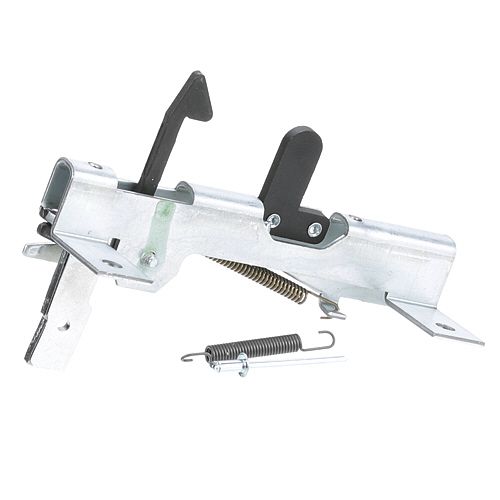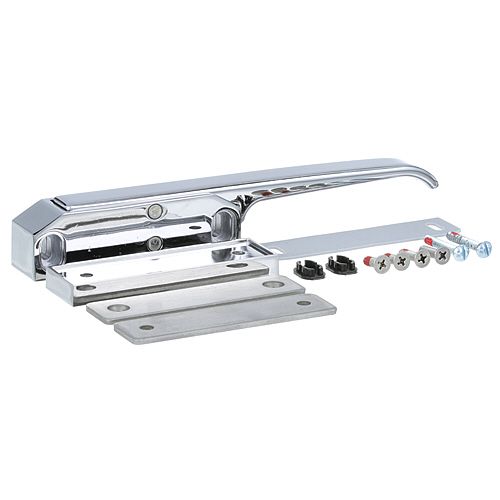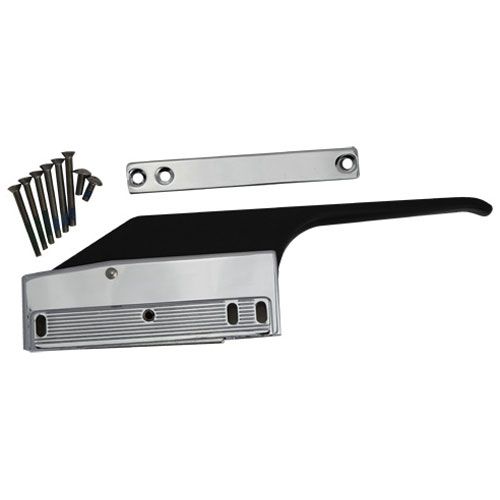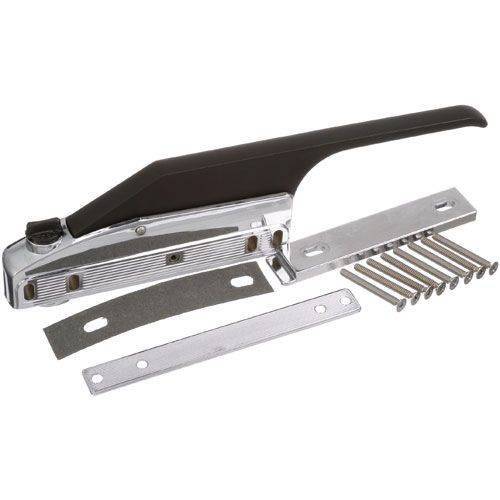Commercial Dishwasher Door Latch Troubleshooting: Here's How to Fix
In the fast-paced world of commercial kitchens, a functional dishwasher door latch is crucial for maintaining efficiency and hygiene. A dishwasher door latch broken or malfunctioning can lead to improper sealing, resulting in leaks, inefficient washing cycles, or even damage to the unit. For many establishments, a malfunctioning dishwasher can bring daily operations to a standstill, leading to lost time and revenue. This not only disrupts kitchen operations, but it also poses a safety hazard in environments demanding cleanliness and reliability. Understanding how to fix these latching issues is essential for restaurateurs, kitchen staff, and maintenance workers alike.
This article offers a comprehensive overview of the steps necessary to diagnose problems related to dishwasher door latches, details the repair and replacement process, and provides preventive maintenance tips to ensure the longevity and efficiency of your equipment.
Understanding the Dishwasher Door Latch Assembly
The dishwasher door latch assembly consists of various components, each designed to work in synchronization to achieve optimal door function. Understanding these parts is essential in troubleshooting latching issues effectively.
Components of the dishwasher door latch assembly
-
Latch mechanism: This is the primary component that secures the door during operation.
-
Strike plate: Often fixated on the door frame, it receives and engages the latch when the door closes.
-
Door handle: Provides access to engage and disengage the latch, allowing easy access to the dishwasher interior.
-
Spring mechanism: Assists in the automatic engagement and disengagement of the latch when the door opens or closes.
-
Mounting bracket: Holds the latch assembly in place on the door and frame.
How the Latch Ensures Proper Operation
To guarantee a tight seal during the washing cycle, the dishwasher door latch is essential. To keep water from seeping out and guarantee that all cycles run smoothly, the latch on the dishwasher door must firmly engage with the striking plate when it closes. If the latch is not functioning properly, it can lead to numerous issues, such as:
-
Water leaks: If the door does not seal properly, water can leak out and create a mess while risking electrical components.
-
Ineffective cleaning: The dishwasher relies on a sealed environment to function effectively; when air enters, it can lead to improper washing.
-
Safety hazards: A malfunctioning latch can cause doors to open unexpectedly during operation, posing a risk of steam burns or electrical shock.
Symptoms Indicating the Dishwasher Door Latch Not Working
A dishwasher door latch not working can manifest in several ways that can affect kitchen operations:
|
Symptom |
Description |
|
Leaking water |
|
|
Error codes on display |
|
|
Unusual noise during cleaning cycles |
|
Common Issues with Dishwasher Door Latches
Recognizing the signs of a broken dishwasher door latch will allow for quick intervention before further damage occurs:
-
The door doesn’t close fully: If you notice gaps when the door is closed, it’s likely due to a faulty latch.
-
Visible damage: Check for cracks or breaks in the latch or the strike plate. Any physical damage compromises the latch's integrity.
-
Difficulty closing: If you have to apply excessive force to close the door, the latch may be misaligned or damaged.
Impact on dishwasher performance
A malfunctioning latch can significantly impact the dishwasher's performance:
-
Compromised cleaning: Poor sealing leads to inefficient cleaning cycles, leaving grease and grime on dishes.
-
Increased energy costs: An inefficient dishwasher consumes more electricity and water, increasing operational costs.
-
Greater wear and tear: Non-optimal functioning puts additional strain on mechanical components, potentially leading to more severe repairs.
How to Fix Dishwasher Door Latch Problems
When dealing with a dishwasher door latch not working, knowing how to fix it promptly can save both time and money. Here is a detailed step-by-step guide to troubleshoot and repair latch issues effectively:
-
Disconnect power: Always begin by unplugging the dishwasher to prevent electrical hazards. Safety should always be your top priority.
-
Inspect the latch: Examine the latch for visible damage or misalignment. Look for cracks, signs of rust, or physical obstructions blocking proper operation.
-
Test the mechanism: Engage and disengage the latch manually to see if it operates smoothly. If it sticks or feels rough, it may require cleaning or lubrication.
-
Clean components: Use warm water and a mild detergent to clean the latch assembly and surrounding areas. Remove any debris or grime that may obstruct the latch.
-
Lubricate the latch: Applying a silicone-based lubricant can facilitate smooth operation. Avoid using oil-based lubricants, as these can attract dust and grime.
-
Reassemble and test: Put the door panel back together, ensuring all components are securely fastened. Plug the dishwasher back in and perform a short cycle while carefully monitoring for any further issues.
How to Repair Dishwasher Door Latch Mechanisms
If you determine the issue transcends simple adjustments, detailed repairs may be necessary. Here’s how to address those challenges:
-
Remove the door panel: Begin by unscrewing the door panel to gain access to the latch assembly. Support the door to prevent it from swinging open too quickly.
-
Examine the latch assembly: Inspect for misalignments, broken components, or spring issues. Often, these components can be easily replaced without requiring total assembly removal.
-
Replace broken pieces: If any components are damaged, you can often find replacements at appliance repair stores or online. Ensure you have the correct model number for compatibility.
-
Reinstall the assembly: Carefully align the latch assembly before securing with screws. It’s important to ensure everything fits snugly to prevent future issues.
-
Adjust tension settings: If your dishwasher model allows it, adjust the tension of the latch by setting screws or springs to ensure a tight seal when the door closes.
When to Consider Dishwasher Door Latch Replacement
In some cases, issues may necessitate a complete dishwasher door latch replacement. Here are the indicators to observe:
-
Severe structural damage: Cracks, dents, or other physical damage that impairs function typically means replacement is the best solution.
-
Continued operational failure: If repairs are consistently required and the latch continues to malfunction, investing in new parts is more economical in the long run.
-
Frequent error codes: If error codes appear with increasing frequency despite successful repairs, a replacement would likely be a prudent move.
Choosing the Right Replacement Parts
When it comes to dishwasher door latch replacement, consider these factors:
-
Brand and model compatibility: Always choose parts specific to your dishwasher brand and model for optimal compatibility.
-
Quality of components: Investing in high-quality replacements can enhance durability, reducing the likelihood of future issues.
-
Ensure a snug fit: Tighten all screws and connectors adequately. Loose parts can lead to further mechanical failures.
-
Test functionality: Ensure the latch functions properly by engaging and disengaging it several times before installing the door panel back on.
Preventive Maintenance Tips
Regular maintenance is essential in avoiding issues related to the dishwasher door latch. Here are key practices to implement:
Regular checks to avoid dishwasher door latch issues
-
Schedule inspections every month to check for any signs of wear and tear. Always observe whether the door is properly sealed throughout operation.
Cleaning and Lubrication Practices
-
Monthly cleaning: Use a damp cloth to wipe down the latch and the surrounding area to prevent the buildup of dirt or grime.
-
Quarterly lubrication: Reapply silicone lubricant to the latch and strike plate to maintain smooth operation.
Scheduling professional inspections
-
Consider scheduling professional maintenance services annually or bi-annually, where trained technicians can conduct thorough checks, ensuring every component functions efficiently and addressing any potential issues before they escalate into costly repairs.
Dishwasher Parts 101: Know the Components for Optimal Performance
Timely maintenance and proactive repairs are crucial in ensuring that your commercial dishwasher remains functional and efficient. Regular checks and understanding how to identify a dishwasher door latch broken or not working empower staff to troubleshoot effectively. Leveraging the troubleshooting steps outlined in this guide will save both time and money, enhancing small repairs before they escalate into broader issues. By properly handling the dishwasher door latch assembly through diligent care, maintenance personnel can extend the lifespan of their equipment significantly, ensuring kitchen operations run smoothly and effectively. PartsFe UK offers a wide selection of commercial dishwasher parts and accessories from top manufacturers such as Jackson and Impeller.
FAQs
Can a faulty dishwasher door latch affect the cleaning performance?
Yes, a malfunctioning dishwasher door latch can prevent the door from sealing properly, leading to water leakage and suboptimal cleaning cycles.
Is it safe to use a dishwasher with a broken door latch?
Using a dishwasher with a dishwasher door latch broken is unsafe as it can cause water leaks, electrical issues, and potential injury. It's advisable to repair or replace the latch before further use.











